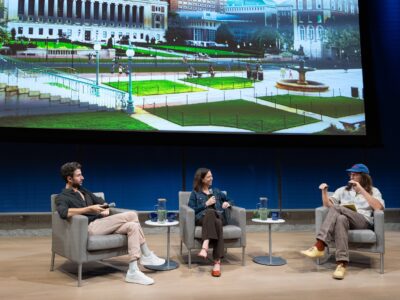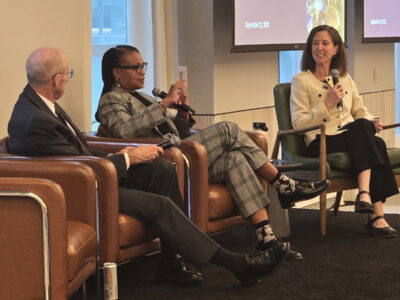
Known for its beauty, the Hochjochferner glacier in South Tyrol, Italy, is a destination for nature lovers, hikers and skiers alike. Now, a new sight accompanies the natural expanse — a permanent installation by Danish-Icelandic artist Olafur Eliasson which sits atop the summit of Mount Grawand. Unveiled at the start of October, the public work, called Our glacial perspectives, combines science, art, and the pure beauty of the surroundings to invite reflection on climate change.
To reach the work, visitors must first traverse a 410 meter (~450 yard) path. Along the rugged path, visitors pass through nine curved metal gates that alternate between black and white. The white gates represent Earth’s ice ages, while the black ones represent warmer periods. The gates are spaced in proportion to the length of the ice ages, “marking a deep-time timeline of our planet, of ice, and of the environment,” Eliasson’s studio commented in their press release.

At the end of the path, visitors reach the main pavilion and a set of large spherical rings. The rings take the shape of an armillary sphere — an early astronomical instrument that was used to model celestial objects in the sky. The work itself can be used in a similar way to the armillary sphere of antiquity. The rings are held by four beams that point to each cardinal direction. Each ring marks the circular path of the sun’s movements throughout the day. The outer ring follows the sun’s motion at the summer solstice, with the middle and bottom rings corresponding to the equinox and winter solstice. “By marking the horizon, the cardinal directions, and the movement of the sun, the artwork directs the visitor’s attention to a larger planetary perspective on the changes in climate that are directly affecting Hochjochferner,” said Eliasson.

The rings are marked by glass in differing shades of greenish-blue. These colors were intended to evoke an early mountaineering tool called the cyanometer, which was used to measure the blueness of the sky. “This measure turned out to not be of scientific importance,” said Eliasson during a lecture at The Brooklyn Rail. “But it was one of these many tools looking for modernity — how to quantify, measure and systematize the world around us.”
‘Our glacial perspectives’, 2020, permanently installed on Grawand Mountain at Hochjochferner glacier, South Tyrol
Commissioned by the Talking Waters Society pic.twitter.com/6bpdGY6hCY
— StudioOlafurEliasson (@olafureliasson) October 26, 2020
The Hochjochferner glacier is one of the many glaciers worldwide subject to the detrimental effects of climate change. In the face of its decline, the glacier has become the subject of research in projects like hiSNOW, an undertaking which seeks to improve the understanding of snow cover and decline in glacier mass balance in the Alps. EURAC Research, a private firm in South Tyrol, sponsored hiSNOW, and has ongoing investigations in its Institute for Alpine Environment.
“During the last expanded glacier extent of the Little Ice Age, a long glacier tongue [from Hochjochferner] descended the upper Rofental [a nearby basin], but glacier recession since then has caused the glacier tongue to be lost, and now a number of smaller glaciers are all that is left of the disintegrated former Hochjochferner,” said Lindsey Nicholson, a hiSNOW project member and a glaciologist at the University of Innsbruck.
Hochjochferner sits between Austria and Italy, and is culturally important in both nations. In 1837, the Freiherr von Alpenburg first described the allure of the glacier — “a lightening of the soul among curmudgeonly individuals.” The glacier also became the subject of a whole lifetime of work by Austrian folklorist and poet Hans Haid. Now, the glacier continues its long connection with the arts as the home of Eliasson’s latest piece.
The artwork’s glacier site is also home to the TalkingWater Foundation, the organization that commissioned the piece. Started by jewelry designer Ui Phoenix von Kerbl and Aveda Cosmetics founder Horst M. Rechelbacher, TalkingWater aims to start a dialogue about water as a resource. The Hochjochferner glacier is part of the Danube watershed that marks the border between Italy and Austria and extends as far as the Mediterranean. “This is a place of strength,” said Kerbl about the foundation headquarters. “Here, water flows from a multitude of artesian springs, forming an allegory for life at these heights: as deep as the glacier rock may be, water always finds its way to the light.”

This is not the first time that Eliasson has used glaciers as the inspiration for his work. In 2019, he presented The glacier melt series 1999/2019. He photographed a glacier in Iceland in 1999, and then returned 20 years later to photograph it again. “Back then, I thought of the glaciers as beyond human influence. They were awe-inspiring and exhilaratingly beautiful. They seemed immobile, eternal,” said Eliasson. “Flying over the glaciers again, I was shocked to see the difference. Of course, I know that global heating means melting ice and I expected the glaciers to have changed, but I simply could not imagine the extent of change.”
Other prominent artists have also used glaciers in their work. Philadelphia-based artist Diane Burko uses glaciers in her paintings that combine both facts and art to convey the impacts of a warming planet. She described the necessity of creating with meaning. “We are all trying in our own way to link everything — science, art, culture — so that we can do something about what we care about,” Burko told GlacierHub. “Artists have a need to create art, but we also have a need to contribute to the conversation and alert people to the issues.”
Like Eliasson, Burko incorporates scientific materials into her work. Her show Seeing Climate Change: 2002-2021 opens next fall at the American University Museum, where she will incorporate large maps and data into her paintings. Burko said that the power of experiencing art can affect a viewer in the way that scientific information alone cannot. “Art can hit people on a different level. If you are walking past these pieces, your brain starts to make connections and find meaning. Eliasson does this masterfully.”

Our glacial perspectives invites the viewer to engage with the changing climate, glaciers, and the planet. Glaciers and art can communicate scientific findings and also foster reflection on one’s relationship to the world.
“Standing at the base of the instrument, you are also 1,000 meters above a glacier with 15 years left. Soon we will have to have a funeral, and I am not sure I have the words to say at a glacier’s funeral,” Eliasson said in a talk at The Brooklyn Rail. “This project sensitizes me. As a child I used to go to mountains where I grew up in Iceland. Completing this project, I feel reborn.”



